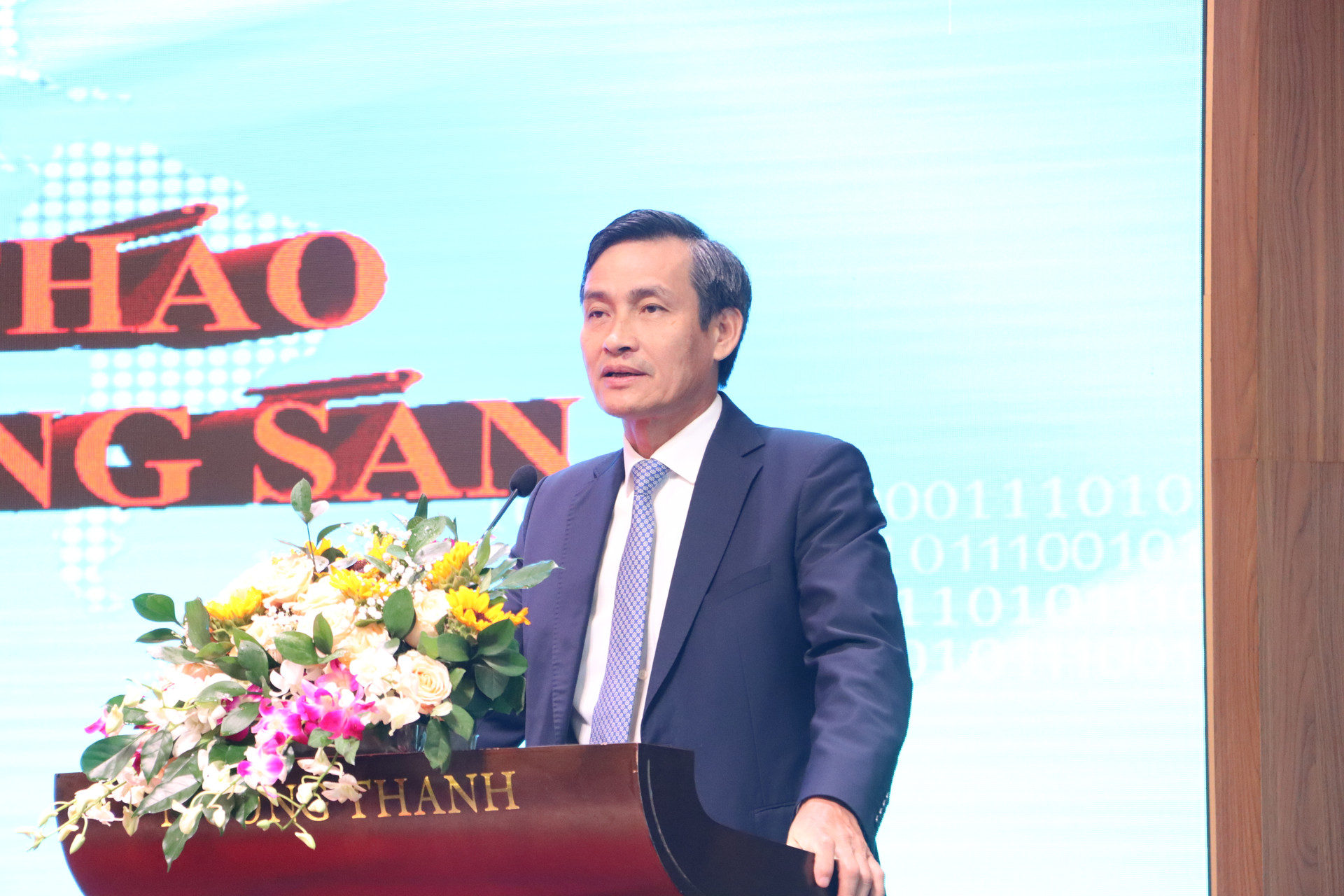How can digital transformation and the establishment of a national database serve as the foundation for transitioning to a circular economy, a green economy, and a low-carbon economy?
Global challenges such as climate change, resource depletion, biodiversity loss, environmental pollution, and ecological imbalances demand a swift transition to sustainable economic models. Digital transformation provides critical tools to enhance management efficiency, optimize resources, and promote sustainable development. Connecting the Land Database (LDB) with the National Database (NDB) on population is a pivotal step in this process, driving economic transformation through big data, AI, the Internet of Things (IoT), cloud technology, and blockchain. This integration is both a technical and strategic solution for Vietnam to achieve its sustainable development goals.
Connecting the LDB with the NDB enables the integration of cross-sectoral data, facilitating natural capital accounting and applying the System of Environmental-Economic Accounting (SEEA). The NDB should integrate resource management data in four dimensions, spanning from the earth’s core to the edge of its atmosphere and encompassing land, water, forests, minerals, biodiversity, carbon credits, and radio and digital resources. It will also monitor production, consumption, and sustainable waste treatment streams. The connection between people, natural resources, ecosystems, the environment, material flows, waste, wastewater, and emissions can be effectively monitored, utilized for regeneration, circulated, and optimized to minimize emissions and waste while promoting efficient resource use.
Digital transformation enhances State management in natural resources and environmental sectors. Connected data systems enable policymakers to make informed decisions based on big data and AI analyses. A real-time, integrated national database optimizes human, material, and financial resource management, including State budgets and investments, forming the foundation for sustainable economic growth. Blockchain ensures data transparency and security, while cloud and IoT technologies enable real-time monitoring, assessment, and forecasting.
An integrated database supports economic, social, and environmental planning using ecosystem-based approaches. It fosters innovation in growth models and promotes green and digital transformations focused on reducing emissions, conserving resources, and protecting the environment.
Cross-sectoral data in circular economic models enables sustainable value chain management, from resource extraction to waste recycling. Integrating land and population data helps identify priority areas for renewable energy, green infrastructure, and carbon credit projects. It also evaluates resource use efficiency, informing policy adjustments for optimized production and consumption. Effective resource management through integrated systems reduces emissions and enhances ecosystems’ carbon absorption capacities.
Biodiversity and emissions data support forest conservation and restoration planning, maintaining natural carbon balances. Population and land data guide green housing, sustainable transport, and smart urban planning, aligning with long-term emission reduction goals.

How can building an environmental monitoring database act as a foundation for decision-making and State management?
An open database on natural resources and the environment is a critical tool to encourage the participation of domestic and international organizations and individuals. Such a system ensures transparency, fosters public-private partnerships (PPPs), supports research and innovation, and develops sustainable solutions for natural resource and environmental management. It also facilitates data sharing, contributing directly to goals like green transition, the circular economy, and climate change response.
Building this system plays a fundamental role in decision-making and State management, especially within the context of digital transformation and sustainable development. It provides accurate, timely environmental quality data and aids State agencies in formulating, adjusting, and implementing policies on environmental protection, climate change response, and sustainable development.
Connecting natural resource and environmental monitoring databases is vital for promoting digital transformation and achieving Vietnam’s sustainable development goals. Through a shared data platform managed by the Ministry of Natural Resources and Environment, databases at the national, ministerial, and local levels are synchronized. These include data on land, water resources, hydrometeorology, marine environments, and other critical areas. Advanced technologies like RESTful API protocols and JSON formats ensure seamless connectivity, compatibility, and data sharing efficiency.
Integrated environmental, biodiversity, waste, and emissions data form the backbone of effective measurement, reporting, and verification (MRV) solutions, such as monitoring waste flows, plastic and carbon footprints, and greenhouse gas emissions. This supports Vietnam’s international commitments, including the Paris Agreement, by providing continuous monitoring and timely data for national greenhouse gas reduction programs.
The system must leverage modern technology to collect, process, and analyze data from diverse sources, such as monitoring stations, sensors, and open community data. It should cover key environmental factors like air and water quality, land use, and climate-related metrics. Advanced tools like AI and big data analysis enhance data collection and processing efficiency.
Ensuring connectivity and compatibility between national, local, and ministerial databases creates a unified, accessible system. Synchronizing air, water, land, and noise monitoring data provides a comprehensive environmental overview, enabling faster, more accurate management decisions.
The environmental monitoring database system not only provides information on the current state of the environment but also supports decision-making on environmental protection measures, disaster response, and sustainable development. State management agencies can utilize data from the system to monitor pollution, assess the impact of development projects, and identify areas needing protection or improvement. The system also aids in early warnings of pollution risks, such as air pollution exceeding thresholds, water quality deterioration, or natural disasters related to climate change, enabling timely response measures.
Environmental monitoring databases play a crucial role in enhancing the transparency and accountability of government agencies while creating opportunities for communities and research organizations to contribute to environmental management. Open data sharing promotes the participation of social organizations, businesses, and individuals in monitoring environmental quality, improving the effectiveness of sustainable development initiatives. It also strengthens cooperation between countries and international organizations in addressing global environmental challenges, such as climate change, biodiversity protection, and natural disaster response.
It is used to build forecasting models, support long-term development strategy planning, and protect natural resources. Developing an environmental monitoring database system serves as a strategic foundation for State management, decision-making, and environmental monitoring. This system will enable State agencies to make more accurate decisions, promote sustainable development, protect the environment, and effectively address global challenges.
What role does connecting the LDB with the NDB play in advancing digital transformation and green transformation?
Land data encompasses information on ownership, usage, value, and status, while population data provides the demographic insights essential for urban planning and socio-economic development. Combining these datasets facilitates the creation of modern urban planning systems, minimizes conflicts, and supports sustainable development.
Real-time monitoring systems are critical for tracking air quality, water resources, and waste, offering timely and accurate data for early warnings. Air monitoring focuses on indicators such as PM2.5, NO2, and SO2 levels in urban and rural areas, while water monitoring targets the quality of rivers, lakes, and groundwater. Waste monitoring, including solid, liquid, and gaseous waste, helps control pollution and optimizes recycling processes. To effectively support these strategies, the SEEA, an international framework for integrating environmental data into national economic accounts, provides a standardized approach to tracking resource flows, valuing natural capital, and measuring ecosystem services such as climate regulation and biodiversity conservation.
An integrated, landscape-based, ecosystem-based approach to natural resource management is an effective method for sustainably managing natural resources, maximizing benefits from ecosystem services such as climate regulation, biodiversity protection, and water supply maintenance. This approach not only aids in managing forests and wetlands but also supports green urban development by integrating ecological corridors and green spaces into planning. At the landscape level, interregional resource management ensures the synchronization of natural, social, and economic factors, minimizing any negative impacts.
Digital transformation integrated with circular, green, and low-carbon economies optimizes the recycling cycle and supply chain using technologies like big data and AI. These tools identify inefficiencies in value chains and enable effective waste reduction and resource management. Supporting policies can be based on economic-environmental impact simulation models, enabling policymakers to develop more effective emission reduction measures. Additionally, digital transformation fosters the development of smart cities, where IoT technologies monitor energy, waste, and environmental quality in real time, optimizing public services and enhancing citizens’ quality of life.
To achieve these goals, Vietnam must address challenges in technology infrastructure, human resources, and funding. Strengthening IT infrastructure, ensuring secure data connectivity, and providing training on digital management tools are essential steps. Mobilizing financial resources, including from international organizations and businesses, is also crucial to building and maintaining a modern national data system.
Connecting the LDB with the NDB is a critical step in the digital transformation strategy, enabling Vietnam to advance its green, circular transformation and low-carbon economy. This integration not only provides environmental benefits but also creates new opportunities for economic development, improves quality of life for citizens, and reaffirms Vietnam’s commitment to combating climate change and protecting the global environment.
Expanding the integration of population data into the land and natural resource management system is another vital step, helping to synchronize data across sectors and establishing a foundation for comprehensive development planning and policy implementation. From land resource management and sustainable urbanization to poverty reduction and environmental protection, all solutions rely on accurate data and strong inter-sectoral connections.
Integrating the LDB, NDB, and environmental monitoring databases represents a strategic move to promote digital transformation in natural resource and environmental management in Vietnam. This approach is not merely a technological advancement but also a strategic foundation that supports Vietnam’s transition to a circular, green, and low-carbon economy. It contributes to global environmental protection, ensures a sustainable future for coming generations, and serves as a powerful catalyst for Vietnam to excel in the global sustainable development process.
Digital transformation and the development of a national database are not just technical foundations but also strategic tools for promoting sustainable development. Integrating tools like SEEA, ecosystem-based approaches, and connecting land, population, and real-time monitoring databases will help Vietnam achieve its sustainability goals, reduce carbon emissions, and respond effectively to climate change. This is not only a necessary solution but also an urgent need to protect the environment, conserve resources, and ensure a high quality of life for current and future generations.









 Google translate
Google translate